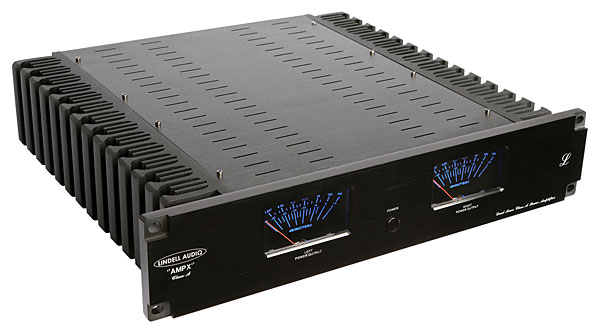Download
Popular Posts
-
Hey, we were in earthquake country, the land from which Carole King may have received inspiration to write, "I Feel the Earth Move...
-
Gibboni and the Gibbon: At Stereo Exchange’s annual Spring High-End Audio Show, Roger Gibboni (left) of Rogers High Fidelity debu...
-
The Enigmacoustics company from Irvine in California has become renowned for the self-energized, horn-loaded Sopranino electrostatic su...
-
A reader once noted that I tend to stick with the same reference gear longer than most reviewers. In addition to Audience's Au24e i...
-
Today, Sony announced an end to production on all MiniDisc players. In a few years, MiniDisc production will cease as well. I know w...
-
The name sounds perfect . It fits neatly next to those of Messrs. Leak, Sugden, Walker , Grant, Lumley, and others of Britain's...
-
Silicon Valley–based Velodyne was founded in 1983 to develop a range of subwoofers that used servo-control to reduce non-linear distorti...
-
I've heard a lot of great audio components over the years, but even in that steady stream of excellence, a few have stood out as so...
-
Once upon a time, in audio's infancy, anyone who wanted better than average sound—average sound during the 1940s being rich, boomy a...
-
I've long kept an eye on Michael Creek's loudspeakers (Epos) and electronics (Creek). He's always moving forward, with eith...
Market information
Blog Archive
-
▼
2013
(510)
-
▼
December
(15)
- This Christmas!
- Audience Au24 SE interconnect
- The Best Jazz Recordings of 2013
- Meet Mat Weisfeld, President of VPI Industries
- The Fifth Element #82
- Audio Beginnings
- My Favorite Records of 2013
- The Entry Level #36
- Lossy Compression: the Sonic Dangers
- Electrocompaniet Classic ECD 2 D/A processor
- Simaudio Moon Evolution 850P line preamplifier
- Listening #132
- Parasound Halo CD 1 CD player
- Stereophile's Products of 2013
- Wilson Audio Specialties Alexia loudspeaker
-
▼
December
(15)
The Fifth Element #82

Norway's 2L label has an enviable track record in choral music. In 2006 they were nominated for Grammys for Best Choral Performance and Best Surround Sound Album, for Immortal Nystedt (SACD/CD, 2L-029-SACD). Knut Nystedt's composition Immortal Bach, performed by Ensemble 96 conducted by Øystein Fevang, is a stunning fractal reworking of J.S. Bach's "Komm, sÅsser Tod." It's available for individual download at www.2l.no, and it costs nothing to listen to the teaser sound byte. (Several other complete performances of the work, done with varying degrees of assurance, can be heard on YouTube.) 2L has since issued a greater proportion of choral recordings than most "audiophile" labels.
2L's latest choral release, Hymn to the Virgin, features Oslo's chamber choir Schola Cantorum under the direction of Tone Bianca Sparre Dahl (SACD/CD & BD, 2L-095-SABD). Disc 1 is an SACD/CD, disc 2 a Pure Audio Blu-ray disc that offers the music in four formats: 24-bit/192kHz LPCM stereo, 24/192 DTS HD MA 5.0-channel, and "mShuttle" FLAC and MP3 for use in portable devices. The master recordings were made in 24/352.8 DXD PCM.
Pure Audio BD's "Unique Selling Proposition" is that it allows for navigation of these audio-only programs without the need for a television or monitor to be connected to the audio system. That is accomplished by use of the colored buttons that are standard on BD player remote controls. Last I heard, interested parties had petitioned the Audio Engineering Society to recognize Pure Audio BD as an audio-engineering standard.
The music on Hymn to the Virgin extends from Bruckner's Ave Maria to contemporary works such as Lauridsen's O Nata Lux, Whitacre's Lux Aurumque, and Gjeilo's Tota Pulchra Es. (There is an official and wonderful video of the Bruckner here.) I found the Gjeilo a pleasant surprise—it had more backbone than other of his works I have heard, which sometimes struck me as innocuous crunchy noodlings. A great pick for the audiophile choral-music fan on your list.
By now, most choral-music fans are aware of England's "supergroup" choral ensemble, Stile Antico. Their latest release, The Phoenix Rising, features Tudor-era works by Byrd, Gibbons, Morley, and Tallis (SACD, Harmonia Mundi HMU 807572). The unifying theme is that those works first came to widespread attention in the 1920s, owing to their having been compiled and published in the Carnegie UK Trust's vastly influential anthology Tudor Church Music. It's another predictably great Stile Antico disc, but if you're unfamiliar with the group, I think the best introduction remains their Music for Compline (SACD, HMU 807419), which I praised in the December 2007 issue.
If you're prepared to open your wallet or checkbook a little wider, an eye-popping bargain is to be had for $150 or less. Deutsche Grammophon is celebrating their early-music imprint, Archiv Produktion, with Archiv Produktion 1947–2013, a 55-CD, 59-hour survey of the label's history (Archiv 529 906-2). The music runs from Anonymous to Zelenka, and chronologically from Gregorian Chant to Beethoven—including knockout performances of the latter's Symphonies 5 and 6 by the Orchestre Révolutionnaire et Romantique under John Eliot Gardiner, in great sound.
Most of the music stands on its own, but a few exceptions fall into the category of "Eat your spinach, it's good for you." One hearing every 35 years or so of Le Jeu de Robin et de Marion, a 13th-century French secular play with music, does it for me, but I listened to the Zelenka CD several times. One-stop shopping gets you a very respectable early-music collection for less than $3 a disc. Highly recommended.
Lindell & the AMPX
Lindell Audio, a Swedish professional-audio company, was founded in 2010 by recording engineer Tobias Lindell, and claims to offer equipment "by engineers, for engineers." Tobias Lindell specifies the features and functions that he wants each product to incorporate; the actual circuit designs are by others. Although Lindell's corporate headquarters are in Sweden, the products are manufactured in China, and are competitively priced.
Lindell makes rack-mount and "lunchbox" compressors, limiters, and microphone preamplifiers. They also make a 32-bit/192kHz digital-to-analog converter, as well as a power amplifier intended to drive passive monitoring loudspeakers such as Yamaha's NS-10 and ProAc's Studio 100.

I became aware of Lindell Audio when I saw a photograph of their handsome AMPX dual-mono, class-A–only power amplifier in an e-newsletter from New York City retailer B&H Photo, which also has a pro-audio division. I was intrigued by the amp's appearance, but I fairly goggled at its suggested US retail price of $1599. I got in touch with Lindell's US importer, RAD Distribution, who agreed to send me a review sample as soon as one was available.
The AMPX arrived in sturdy double boxing—prudent, given that it weighs about 42 lbs. The loaner obviously had been around the block a few times. It showed some signs of wear, and its footers' rubber inserts were missing, along with its power cord and manual. No big deal on any count. Anyway, I'd rather have an experienced review sample than one that someone might later claim to have needed 500 hours of break-in.
RAD sent me a new set of footers, and Tobias Lindell told me that new amps come with all of the aforementioned items, plus a cloth bag and a pair of cotton gloves. So much for the oft-heard claim that reviewers get special treatment.
At 18.8" (483mm) W by 3.5" (90mm) H by 17.4" (445mm) D, the AMPX is one rack unit wide. Its faceplate, machined for rack mounting, is heavy, about 3/8" thick, and dominated by two large, blue power meters (wonder where they got that idea from?), calibrated to show watts into 8 ohms. The stated power output is 20Wpc, which, after extensive listening, strikes me as a conservative claim. Centered between the power meters is a round black pushbutton for On/Off—apparently just that, not standby. There are front-panel legends with the maker's logos, model name, and descriptions in script. On startup, the meters blink for about five seconds; perhaps some diagnostic function is going on. I downloaded the owner's manual from Lindell's website, but it was silent on that issue.
The sides of the AMPX are occupied by thick-finned modular heatsinks, considerately designed with slightly chamfered edges to reduce the risk of cut fingers—this is one dense amp. For some reason, however, it looks lighter than it is. The heatsinks got so hot that placing the AMPX in the bottom of a rack full of equipment would probably be unwise. I estimated the temperature of the heatsinks to max out at about 124°F.
The rear-panel layout is mirror-imaged, reflecting the AMPX's dual-mono construction. Lindell claims that the right and left power supplies are completely isolated from each other. An IEC power-cord inlet is in the middle; to either side of it are the speaker binding posts, then the input jacks. The connection hardware is respectable but not ne plus ultra. Input is by XLR connectors only; RCA input is not an option. The circuit design itself is single-ended, so the balanced inputs are unbalanced by op-amps.
One unusual and potentially useful feature is that both channels' female XLR inputs are mirrored by a corresponding male XLR output (or, rather, throughput). If your speakers are biampable, you could vertically biamp them with two AMPXes. In that scenario, the input signal would go into one channel, then an XLR jumper cable would connect that channel's throughput jack to the other channel's input, giving you a biamped total of 40Wpc.
Tobias Lindell describes his circuit design as being "rather simple." He arrived at the decision to offer an energy-inefficient class-A–only design entirely through listening tests—nothing else sounded as good. To reach an output of 20Wpc, each channel uses four pairs of complementary Sanken 2SA1695 PNP and 2SC4468 NPN output transistors.
Lindell claims for the AMPX a frequency response of 10Hz–100kHz, ±1.5dB, a signal/noise ratio greater than 100dB, and the virtues of "high resolution, high headroom, accurate, easy-to-mix sound at an affordable price."
Source : stereophile[dot]com

- Không có bài viết liên quan

Comments[ 0 ]
Post a Comment